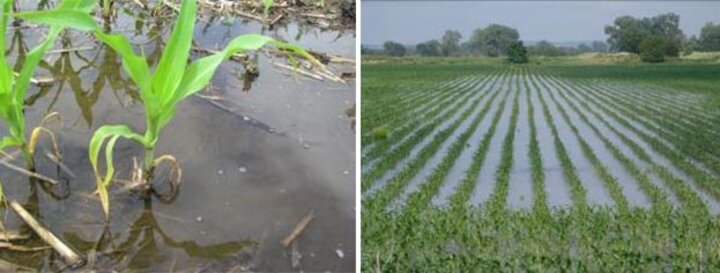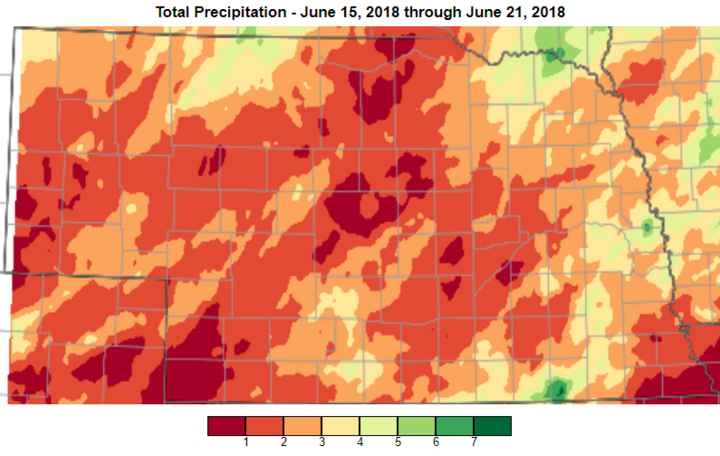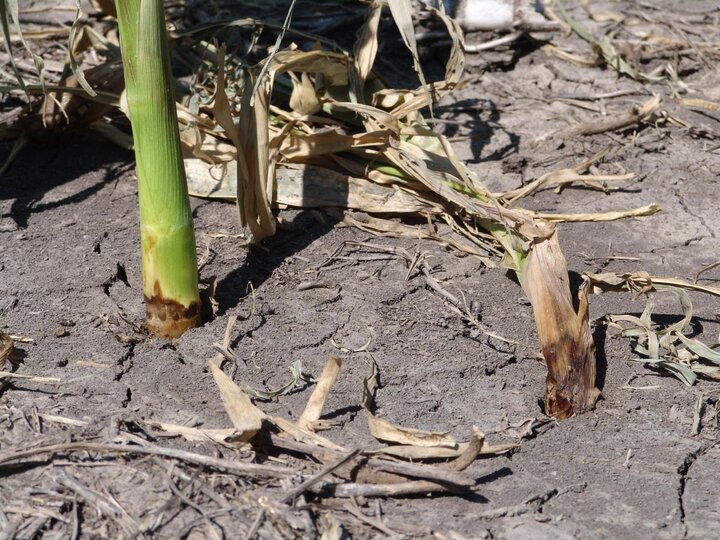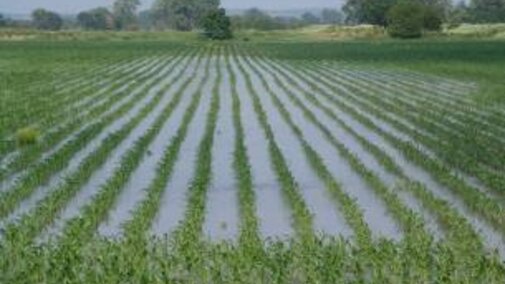
Amy's kids have been singing “rain, rain, go away” this past week and are ready for some sunshine to poke out. In many areas these rains were welcomed by the crops and allowed growers to delay starting the pivots. In other fields, however, heavy rains over several days (Figures 1 and 2) resulted in ponded or flooded fields and concerns about possible effects on the corn.
The extent to which flooding damages corn depends on several factors, including:
- growth stage of the corn at flooding,
- frequency and duration of flooding, and
- air-soil temperature during flooding.

The most important impact of flooding is on overall plant respiration. When flooding occurs, there is a reduction in the exchange of air (oxygen) between the soil and atmosphere. This leads to decreased total root volume, reduced water and nutrient transport through the roots to the shoots, and an accumulation of sulfides and butyric acid produced by microorganisms. (These compounds are toxic to the plant.) Depending on the length of time the roots are waterlogged it could lead to cell and root death and eventually plant death.
Corn development stage is variable across the state, depending on hybrid and planting date. Currently in Holt County, corn growth stages range from just emerging to V8. In other locations corn is at V12.
Germinating to V6
For corn that is at development stage V6 (six visible leaf collars) or smaller, the growing point is still near or below the soil surface. These plants can survive only two to four days of flooding. The chance of plant survival increases dramatically if the growing point is not completely submerged (as with older corn) or submerged for less than 48 hours. However, if temperatures are greater than 77°F, plants may not survive 24 hours. Research has demonstrated yield reductions for 6-inch and 30-inch corn ranging from 5% to 32%, depending on soil nitrogen availability and duration of flooding.
V7 to V10
Once corn reaches V6, its ability to “handle” standing water increases dramatically due to a deeper root system that can recover quicker from the lack of oxygen in the soil. However, corn from V6-V10 cannot live forever in standing water. Research has shown that corn can tolerate standing water for 7 to 10 days, depending on the temperature. Even with a deeper root system, the plant will still have difficulty moving water throughout the plant due to lack of root function. With this in mind, when temperatures are above 860F, plant stress will occur and decrease the plant’s tolerance to standing water. Yield losses will vary depending on duration of flooding, temperature, and nutrient availability.
Pretassel to Silking
Corn that is reaching pretassle through silking—VT to R1— becomes “sensitive” to flooding once again. These are the most critical stages of corn development and thus the plant has its lowest tolerance to excessive soil moisture or standing water. Excessive soil moisture or standing water causes a lack of nutrient uptake in the plant. This can lead to pollination failure and severely reduce yield potential. In general the corn can tolerate no more than two to four days of standing water during this critical growth stage before yield loss become severe.
Assess Survival
For corn V6 and smaller after the water recedes examine the color of the growing point, if present. The radicle (root) and coleoptile (shoot) should appear white or cream colored. Germinating seeds can be cut in half to determine if turgor pressure is still present. If the seed is extremely soft and does not hold form, the probability for survival is slim. New growth should resume three to five days after the water recedes.
Nitrogen Management Considerations
No matter the growth stage of the crop, there will be concerns about denitrification or nitrogen leaching and decreased nutrient availability that may result in nitrogen deficiency later in the growing season. In fields where ammonium-based fertilizers were applied within days before soil conditions became saturated, the potential for N loss from fertilizer is minimal. However since urea is water soluble, there is potential for leaching or off-site movement of N. In sandy soils or heavily tile-drained soils, urea or nitrate can move as much as a foot for each inch of rain. Compare this with clay loam or silt loam soil where movement is five to six inches for each inch of rain. Once the sun comes back out, nitrates will start moving back up in the soil profile due to evaporation from the soil surface causing an upward suction force that moves the nitrate and water closer to the soil surface. Also, evapotranspiration from actively growing crops will result in a similar suction force allowing the crop access to some of the nitrates again.
In fields where N from fertilizer or organic N was in nitrate form before the soils became excessively wet will have nitrogen loss. In fine-textured soils, N is lost through denitrification in saturated soil conditions. Denitrification rates increase after about a day under oxygen-depleted conditions when the soil pore space is filled with water. When these conditions exist, soil microbes use nitrate for respiration. This, in turn, releases N as a byproduct in a gaseous form that is lost to the atmosphere. It is possible to lose as much as 5% of the nitrate-N in the soil for each day the soil remains saturated with water under warm soil temperatures. In coarse-textured soils or soils intensively tiled, the majority of the N loss will occur by leaching below the root zones or into tile lines.
It is important to remember that corn’s nitrogen uptake from emergence through V6 only represents about 5% of the total plant uptake. However, starting at V8 there is a rapid accumulation of N by the plant, with about 60% of the total N uptake occurring between V8 and silking –R1. Thus it is important to scout fields for early season N-deficiency and, if deficiency symptoms occur, apply supplemental N either as sidedress or through fertigation.
Corn Diseases That Develop Following Flooded Conditions
Saturated soils and flooded conditions promote a number of diseases in corn that producers and crop consultants should watch for now and later in the season. Wet conditions are favorable for several pathogens to sporulate, germinate, and/or infect plants. Below are a few of the diseases that are more common in corn subjected to flooded conditions.
Crazy Top. One easily recognized disease is crazy top of corn, which causes a leafy proliferation of the tassel (Figure 2) and sometimes, the ear. The pathogen requires standing water for spores to swim and infect plants systemically. The disease rarely causes substantial yield loss and there are no rescue treatments available for it.
Stalk Rots. Fungal stalk rot diseases and lodging are common in areas that were flooded. So, revisit these areas throughout the season to monitor stalk quality and prioritize fields for harvest to avoid losses due to lodging. Stalk rot diseases tend to develop in previously flooded corn because of the loss of nitrogen during heavy rain and flooding. Nitrogen-deficient plants often use more resources in the stalks during grain fill, leaving them weakened and prone to disease and lodging. Affected plants have softened or degraded pith (Figure 3) inside the stalks that may eventually become hollow. Hollow stalks are weaker and prone to lodging because they cannot support the weight of the ear during high winds. For more information about stalk rot diseases, see the UNL Extension Circular, Common Stalk Rot Diseases of Corn (EC1898).
Bacterial Stalk Rot. Corn in standing water is often infected low on the stalk near the soil line by the bacteria causing bacterial stalk rot. Ultimately, infected plants could develop lesions that spread to wrap around and/or up the stalk and may lead to stalk collapse and premature death (Figure 4). Bacterial stalk rot usually creates a distinctly foul odor in infected plant tissue and can be dark and slimy.
For more information on these and additional diseases to expect in wet conditions, see Corn Disease Profiles: Diseases Favored by Wet Conditions, (EC1909) or the Corn Disease Management section of CropWatch.




